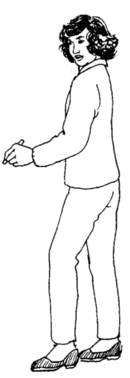Hesperian Health Guides
Do a Health Care Waste Assessment
HealthWiki > A Community Guide to Environmental Health > Chapter 19: Health Care Waste > Do a Health Care Waste Assessment


Steps in doing a health care waste assessment
- Meet and discuss problems with all health care staff.
- List what is in the pharmacy and supply room.
- Make a map of the center.
- Walk through the health center and note problems.
- Learn about different choices for treating and disposing of waste.
- Find out how waste is handled and disposed of, both at the health center and in the community.
- Take action!
- Regularly educate and train all workers.

1. Meet and discuss problems with all health center staff.
Everyone at the center should help with the assessment. Doctors, nurses, waste handlers, and cleaners are likely to have different ideas about where waste is coming from and what the problems are.

2. List what is in the pharmacy and supply room.
Since most materials are ordered through the pharmacy or supply room, start your assessment by making a list of what you find in those places. As you look at each item, ask what kind of waste will be produced, and how harmful it will be.
Since most materials are ordered through the pharmacy or supply room, start your assessment by making a list of what you find in those places. As you look at each item, ask what kind of waste will be produced, and how harmful it will be.
3. Make a map of the health center.
Show all rooms, doors, and windows, and note what each room is used for. Use different colors to mark places where waste is created, where waste containers are kept, and where waste is stored as it is collected and transported from its source to its final storage or disposal site. This map can be changed as the group walks through the health center. After the assessment, make a new map to show any changes that have been made. Notice especially where containers are kept for collecting waste.
Show all rooms, doors, and windows, and note what each room is used for. Use different colors to mark places where waste is created, where waste containers are kept, and where waste is stored as it is collected and transported from its source to its final storage or disposal site. This map can be changed as the group walks through the health center. After the assessment, make a new map to show any changes that have been made. Notice especially where containers are kept for collecting waste.

4. Walk through the health center and note problems.
Visit all the areas where waste is produced. Look in the trash bins and note what kinds of waste are there. Do this walk-through several times over the next few weeks, and try to do it at different times of day. Then you can see the waste in different conditions and how it is handled throughout the day.
Visit all the areas where waste is produced. Look in the trash bins and note what kinds of waste are there. Do this walk-through several times over the next few weeks, and try to do it at different times of day. Then you can see the waste in different conditions and how it is handled throughout the day.
Do the walk-through with different workers. Cleaners will see things differently from doctors and nurses, and each may have important ideas about how to best handle waste.

The safest way to protect myself from used needles is to have them put in
puncture-proof boxes.
puncture-proof boxes.
The safest way to protect myself from used needles is to toss them straight into the waste pail.
The safest way to protect myself from used needles is to let the nurse give injections.
To manage waste safely, we need to think about each other as much as we think about ourselves.

5. Learn about different choices for treating and disposing of waste.
After several walks through the health center, have a group discussion about the problems and possible solutions. Solutions do not have to be expensive or technical. Most solutions require only organization, cooperation, and commitment. Try to make a plan that starts with the most harmful waste — sharps — and then chemicals, blood and other body fluids, and so on. The goal is to improve your entire system, not just 1 part of it.
After several walks through the health center, have a group discussion about the problems and possible solutions. Solutions do not have to be expensive or technical. Most solutions require only organization, cooperation, and commitment. Try to make a plan that starts with the most harmful waste — sharps — and then chemicals, blood and other body fluids, and so on. The goal is to improve your entire system, not just 1 part of it.
6. Find out how waste is handled and disposed of.
Follow waste from where it is made, to where it is stored, and where it leaves the health center. Is the waste picked up regularly? How is it collected? Do waste handlers wear gloves, shoes, or other protective clothing? Is it transported in safe containers?
Follow waste from where it is made, to where it is stored, and where it leaves the health center. Is the waste picked up regularly? How is it collected? Do waste handlers wear gloves, shoes, or other protective clothing? Is it transported in safe containers?

Waste handlers often sell whatever they can to junk dealers. This can be safe or dangerous depending on how waste is separated and disinfected. Do waste collectors pull reusable and recyclable materials out of the waste safely? Is there a way to make a safer system for those who make a living handling or selling waste?
Is the waste taken to a dump site or an incinerator? If possible, visit the place where waste is dumped. Does it remain separated, or is it mixed with other kinds of waste? Does it lead to health risks for the community, such as sharps in an open dump site?
Is the waste taken to a dump site or an incinerator? If possible, visit the place where waste is dumped. Does it remain separated, or is it mixed with other kinds of waste? Does it lead to health risks for the community, such as sharps in an open dump site?
7. Take action!
What happens in the health center eventually touches everyone in the community. Taking even small steps to make waste handling safer will reduce harm to people and the environment. Which improvements are possible for the health center to make now? How can the health center influence what happens to waste once it is taken away to a landfill or incinerator?
What happens in the health center eventually touches everyone in the community. Taking even small steps to make waste handling safer will reduce harm to people and the environment. Which improvements are possible for the health center to make now? How can the health center influence what happens to waste once it is taken away to a landfill or incinerator?
8. Regularly educate and train all workers.
The success of any safety plan relies on continuing to educate and train everyone who handles and creates health care waste. It is easy to become careless with safety practices when nothing harmful seems to happen. Repeating a waste assessment every year can help remind people of the importance of being careful.
The success of any safety plan relies on continuing to educate and train everyone who handles and creates health care waste. It is easy to become careless with safety practices when nothing harmful seems to happen. Repeating a waste assessment every year can help remind people of the importance of being careful.
This page was updated:05 Jan 2024


